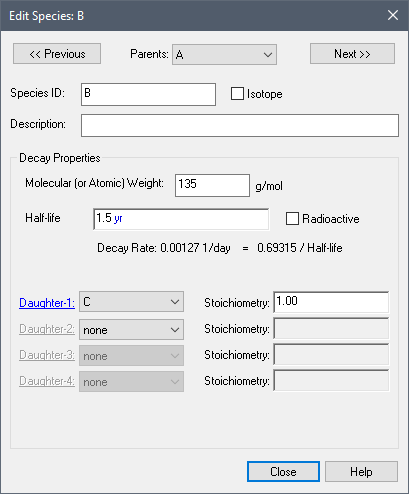 Note: You can only edit
“user-defined” species that you have manually added to the species list. You
view, but cannot edit properties for species that are included in the list from
the ICRP Database provided by GoldSim within the RT Module.
Note: You can only edit
“user-defined” species that you have manually added to the species list. You
view, but cannot edit properties for species that are included in the list from
the ICRP Database provided by GoldSim within the RT Module.
GoldSim allows you to specify that a species decays as it is transported through the system. When a species decays, it can either disappear from the system (i.e., remove mass from the system), or (if you have the RT Module) it can be transformed into up to four reaction products (referred to as daughters).
 Note: You can only edit
“user-defined” species that you have manually added to the species list. You
view, but cannot edit properties for species that are included in the list from
the ICRP Database provided by GoldSim within the RT Module.
Note: You can only edit
“user-defined” species that you have manually added to the species list. You
view, but cannot edit properties for species that are included in the list from
the ICRP Database provided by GoldSim within the RT Module.
Decay can be defined in terms of a half-life or a first-order decay rate. All species must be defined in the same manner. The manner in which decay is specified is selected on the main species dialog:

By default, decay is defined using half-lives.
The manner in which a species decays is described in terms of the Half-life (or Decay Rate), the Molecular (or Atomic) Weight, the Daughters, and the Stoichiometry.

Half-life: If decay is specified using half-lives, you must enter a half-life for each species (assuming first-order decay). It must have units of time. Note, however, that by making the half-life a function of the concentration of other species, or of other model parameters (e.g., temperature), nearly any complex reaction can be represented. The decay rate of each species is computed as ln(2)/Half-life. The decay rate is displayed directly below the field using the Time Display Units specified in the Simulation Setting dialog.
 Note: By default, half-lives
for new species default to zero. GoldSim interprets a zero half-life as
meaning there is no decay (as opposed to assuming the species decays
instantaneously).
Note: By default, half-lives
for new species default to zero. GoldSim interprets a zero half-life as
meaning there is no decay (as opposed to assuming the species decays
instantaneously).
Decay Rate: If decay is specified using decay rates, you must enter a first-order decay rate for each species. It must have units of inverse time. Note, however, that by making the decay rate a function of the concentration of other species, or of other model parameters (e.g., temperature), nearly any complex reaction can be represented. The half-life of a species with a first-order decay rate is computed as ln(2)/Decay Rate. The half-life is displayed directly below the field using the Time Display Units specified in the Simulation Setting dialog.
Molecular (or Atomic) Weight: This is the molecular or atomic weight of the species. If solubilites are defined based on moles, it is used to convert those to mass based values. When using the RT Module, it is also used to compute the mass of reactants produced based on the stoichiometry which is specified and is required in order to compute the specific activity of radioactive species. Note that this must be entered as a number (it does not accept links).
Daughter-1 through Daughter-4: These are the decay (reaction) products for the species. You can specify up to four daughters. The drop-down list includes all of the other species in the model. The default is "none". These fields are not available (grayed out) in the CT Module.
Stoichiometry: This is the stoichiometric (molar) ratio, and must be specified for each daughter. It defines the number of moles of daughter produced for each mole of the species which decays. For example, if species A decayed to daughters B and C according to the following reaction:
3A ⇒ 2B + 5C
then the stoichiometry for B would be 0.67 (2/3) and the stoichiometry for C would be 1.67 (5/3). Thes fields are not available (grayed out) in the CT Module.
You can move through the existing species by using the Previous and Next buttons at the top of the Species definition dialog. If daughters are defined, you can jump directly to those daughters by clicking on the label (e.g., Daughter-1). Similarly, if the species has a parent, you can jump directly to a parent by clicking on the label at the top of the page.
Learn more about:
Modeling Complex Chemical Reactions